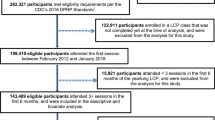Abstract
Among women aged 50 to 69 years, regular screening by mammography in combination with clinical examination, can substantially decrease the morbidity and mortality associated with breast cancer by facilitating early detection. Unfortunately, many Canadian women are not screened in accordance with current guidelines. Research to date is based primarily on large surveys conducted in the United States and less is known about the relevance of specific barriers to mammography screening among Canadian women.
Multivariate results from the 1994–95 National Population Health Survey (NPHS) indicate that younger (40–49) and older (70+) women, those who are socioeconomically disadvantaged, and minority women are least likely to report having had a mammogram. Conversely, women with positive health behaviours, high social support, and positive mental health attributes are more likely to participate in mammography screening. These findings are discussed in terms of the implications for developing successful intervention programs for Canadian women and for setting priorities for further research.
Résumé
Des examens réguliers de mammographie peuvent diminuer substantiellement la morbidité et la mortalité associées au cancer du sein en facilitant le dépistage le plus tôt possible, chez les femmes âgées de 50 à 69 ans. Malheureusement, conformément aux lignes directrices actuelles, beaucoup de femmes canadiennes ne subissent pas de test de dépistage. La recherche à ce jour est basée principalement sur des études à grande échelle menées aux États-Unis et on en sait très peu sur la relation entre les barrières spécifiques et les tests de dépistage de mammographie chez les femmes canadiennes.
Les résultats multivariés de l’Enquête nationale sur la santé de la population de 1994–1995 indiquent que les femmes plus jeunes (40–49) et plus âgées (70+), celles qui sont socio-économiquement désavantagées, et les femmes minoritaires sont les moins susceptibles de rapporter avoir passé une mammographie. Inversement, les femmes avec des comportements de santé positifs, un soutien social élevé, et des attributs de santé mentale positive sont plus susceptibles de participer à des examens de dépistage par mammographie. Ces résultats sont discutés en fonction des implications au niveau du développement de programmes d’intervention à succès pour les femmes canadiennes et au niveau de l’établissement des priorités pour les recherches futures.
Similar content being viewed by others
References
National Cancer Institute of Canada. Canadian Cancer Statistics 1996. Toronto, Canada: National Cancer Institute of Canada, 1996.
Miller AB, Baines CJ, To T, et al. Canadian National Breast Screening Study: 1. Breast cancer detection and death rates among women aged 40–49 years. Can Med Assoc J 1992;147:1459–76.
Miller AB, Baines CJ, To T, et al. Canadian National Breast Screening Study: 2. Breast cancer detection and death rates among women aged 50–59 years. Can Med Assoc J 1992;147:1477–88.
Canadian Task Force on the Periodic Health Examination. Screening for breast cancer. The Canadian Guide to Clinical Preventive Health Care. Ottawa: Minister of Supply and Service, Health Canada, 1994;789–95.
O’Connor AM, Perrault DJ. Importance of physician’s role highlighted in survey of women’s breast screening practices. Can J Public Health 1995;86:42–45.
Anderson LM, May DS. Has the use of cervical, breast, and colorectal cancer screening increased in the United States? Am J Public Health 1995;85:840–42.
Breen N, Kessler L. Changes in the use of screening mammography: Evidence from the 1987 and 1990 National Health Interview Surveys. Am J Public Health 1994;84:62–67.
Bryant H, Mah Z. Breast cancer screening attitudes and behaviors of rural and urban women. Prev Med 1992;21:405–18.
Calle EE, Flanders WD, Thun MJ, et al. Demographic predictors of mammography and Pap smear screening in US women. Am J Public Health 1993;83:53–60.
Katz SJ, Hofer TP. Socioeconomic disparities in preventive care persist despite universal coverage: Breast and cervical cancer screening in Ontario and the United States. JAMA 1994;272:530–34.
National Cancer Institute Breast Cancer Screening Consortium. Screening mammography: A missed clinical opportunity? Results of the NCI breast cancer screening consortium and national health interview survey studies. JAMA 1990;264:54–58.
Zapka JG, Stoddard AM, Costanza ME, et al. Breast cancer screening by mammography: Utilization and associated factors. Am J Public Health 1989;79:1499–502.
Hammond JMS, Stewart M. Female patients’ attitudes to mammography screening. Can Fam Phys 1994;40:451–55.
Kang SH, Bloom JR. Social support and cancer screening among older black Americans. J Natl Cancer Inst 1993;85:737–42.
Kang SH, Bloom JR, Romano PS. Cancer screening among African-American women: Their use of tests and social support. Am J Public Health 1994;84:101–3.
Urban N, Anderson GL, Peacock S. Mammography screening: How important is cost as a barrier to use? Am J Public Health 1994;84:50–55.
Statistics Canada. National Population Health Survey (NPHS): Public Use Microdata File Documentation 1994–1995. Ottawa: Health Statistics Division, Statistics Canada, 1995.
Kelsey JL, Thompson WD, Evans AS. Methods in Observational Epidemiology. New York: Oxford University Press, 1986.
SAS Institute Inc. SAS User’s Guide, release 6.10. Cary, NC: SAS Institute Inc., 1994.
Wong CH. Use of weights in sample surveys. PHERO 1992;3:230–32.
Author information
Authors and Affiliations
Corresponding author
Additional information
This research was funded by the Disease Prevention Division of Health Canada.
Rights and permissions
About this article
Cite this article
Maxwell, C.J., Kozak, J.F., Desjardins-Denault, S.D. et al. Factors Important in Promoting Mammography Screening Among Canadian Women. Can J Public Health 88, 346–350 (1997). https://doi.org/10.1007/BF03403903
Received:
Accepted:
Published:
Issue Date:
DOI: https://doi.org/10.1007/BF03403903




